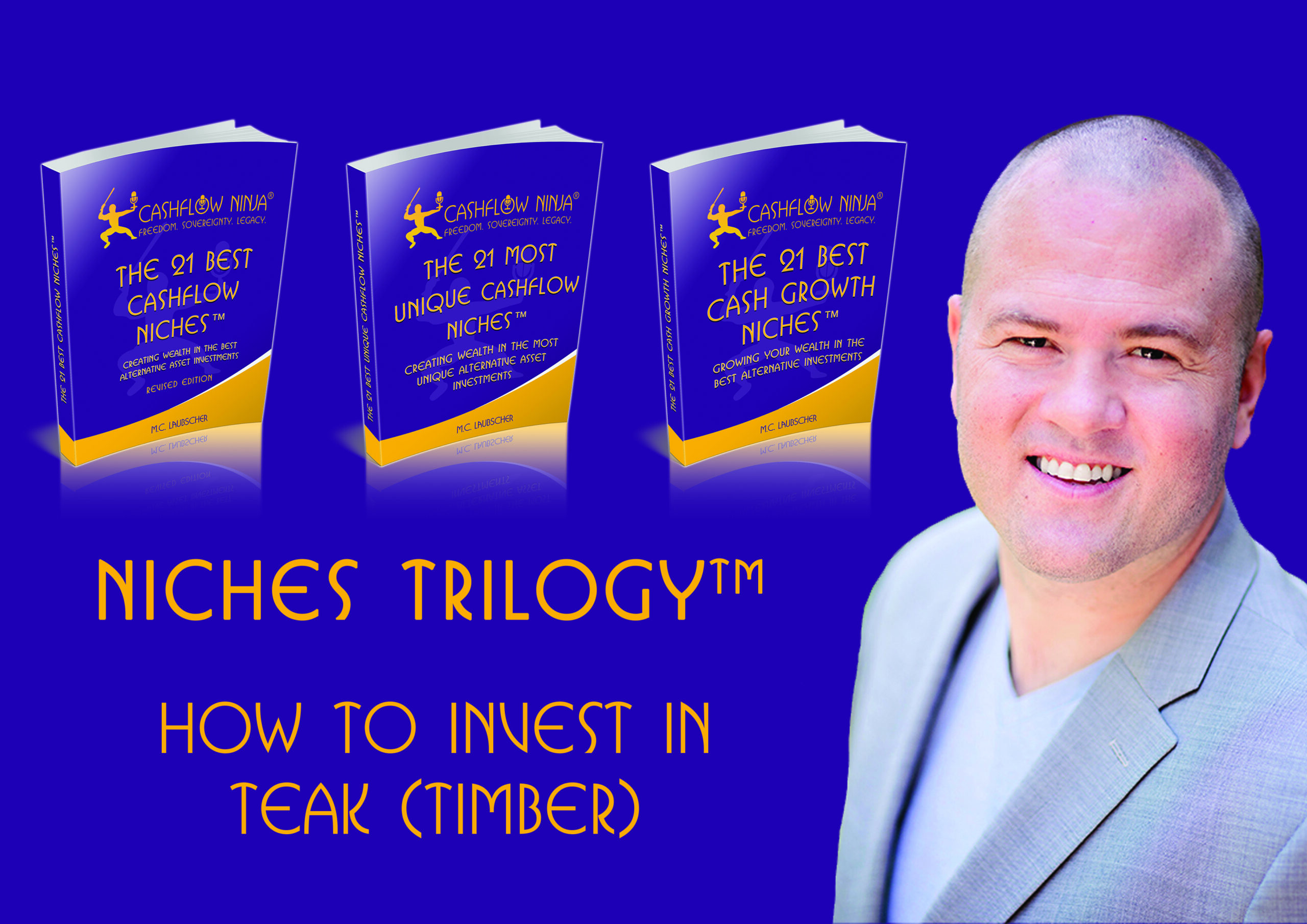
Teak (timber) as an investment asset class involves putting money into teak wood plantations or timberland, where teak trees are cultivated and harvested for their valuable wood. Teak is a highly prized tropical hardwood known for its durability, strength, and resistance to weather, pests, and decay. It is famous for various applications, such as furniture, boat building, and construction. Investing in teak offers several distinctive characteristics, making it an appealing option for investors.
Why Invest In Teak?
One main reason investors are drawn to teak is its long-term growth potential. Teak trees typically require 20-25 years to mature, and their wood becomes increasingly valuable as they age. This extended growth period offers the potential for significant appreciation in the value of timber.
The high demand for teak wood is another compelling factor for investors. Teak’s strength and durability make it ideal for high-end furniture, boat building, and construction, ensuring a steady demand that can lead to stable or increasing prices over time. Additionally, investing in teak provides portfolio diversification. As a real asset, teak’s market performance is generally not correlated with traditional financial markets, offering investors a hedge against market volatility.
Sustainable and renewable resource management is another key aspect of teak investment. Responsibly managed teak plantations contribute to sustainability through practices such as replanting and adhering to environmental standards, making teak an appealing option for those interested in sustainable and renewable assets. Furthermore, teak serves as a hedge against inflation, as tangible assets like timber often retain or increase their value when the value of money decreases.
Investors focused on sustainable and socially responsible investing may find teak particularly attractive due to its potential for positive environmental and social impacts, especially in plantations that are managed responsibly. Additionally, the land on which teak is grown can be appreciated, offering another avenue for potential investment returns. However, like any investment, teak carries its own risks and challenges, requiring careful consideration, planning, and knowledge of forestry and timber markets.
The Teak Ecosystem
The teak (timber) ecosystem is an extensive network that includes the cultivation, management, harvesting, processing, and distribution of teak wood, involving a range of stakeholders and processes essential for the sustainable production and use of this valuable timber. This ecosystem’s foundation is teak plantations and forestry management, where teak trees are grown in tropical regions, particularly in countries like Indonesia, Myanmar, Thailand, and parts of Central and South America. Sustainable forestry practices, such as selective harvesting, replanting, and responsible land management, play a crucial role in maintaining the health of these plantations and the surrounding environment.
Harvesting and processing is a critical stage in the teak ecosystem. Mature teak trees, typically harvested between 20 and 25 years of age, are processed to produce high-quality wood, involving steps like sawing, drying, and treating. The global trade and distribution of teak wood are significant, with many producing countries exporting teak internationally. This supply chain includes various intermediaries, such as exporters, importers, wholesalers, and retailers, who facilitate the movement of teak from plantations to end-users.
Due to its strength, durability, and resistance to environmental factors, market demand for teak is driven by its use in various industries, including furniture making, boat building, construction, and flooring. Consumer demand is also influenced by teak’s quality, aesthetic appeal, and reputation as a premium hardwood. In terms of investment and finance, investors may opt to invest directly in teak plantations or through timber investment funds, attracted by the potential for long-term growth and sustainability. Market demand, timber prices, and forestry management practices influence the financial performance of these investments.
The environmental and social impact of teak plantations is another vital aspect of the ecosystem. Responsibly managed plantations can support biodiversity, soil conservation, and carbon sequestration and provide economic benefits to local communities, including employment and infrastructure development. Regulatory and certification bodies play a role in maintaining standards and ensuring compliance. Organizations like the Forest Stewardship Council (FSC) provide certification for sustainably managed forests, and compliance with local and international forestry regulations is essential for sustainable and legal teak production.
Overall, the teak ecosystem is a dynamic and complex network that balances economic, environmental, and social factors, highlighting the importance of sustainable and responsible practices in cultivating and using teak timber.
How To Grow Cash
Investors can make money and grow their cash by investing in teak (timber), utilizing various strategies that capitalize on the unique attributes of this tropical hardwood. Known for its durability and resistance to environmental factors, teak is a valuable material in several industries. The primary way investors profit from teak is through long-term capital appreciation. Teak trees typically require 20-25 years to mature, and as they age, the value of the wood increases. This extended growth period provides significant potential for capital appreciation.
Direct investment in teak plantations is a popular strategy. Investors can purchase land with existing teak trees or invest in developing new plantations. This approach allows them to benefit from the entire growth cycle of the trees. Alternatively, investors can participate in teak investment funds, similar to mutual funds. These funds aggregate money from investors to invest in teak plantations. They are managed by professionals who handle the trees’ cultivation, maintenance, and eventual harvest, distributing the profits among the investors.
Another critical aspect of teak investment is harvesting and selling the timber. Once the teak trees mature, they are harvested and sold, with the income generated from the sale of the mature wood representing the return on investment. The high demand for teak in furniture making, boat building, and construction enhances its market value.
In addition to the timber’s value, the land on which teak is grown can also appreciate over time, offering another potential return on investment. Teak presents an attractive option for sustainable and environmentally friendly investments. Responsibly managed teak plantations can contribute to environmental conservation, potentially yielding carbon credits or other ecological incentives.
Investing in teak involves a long-term commitment and comes with risks related to market fluctuations, environmental factors, and management challenges. Investors must conduct thorough research, consider these risks, and work with experienced managers with forestry expertise. Diversification within teak investments and asset classes can also help manage risk effectively.
How To Lose Money
Investing in teak (timber) involves certain risks; if not effectively managed, investors can incur financial losses. Like any investment, teak comes with its unique set of challenges and potential pitfalls that require careful consideration. One of the main risks is the long growth period of teak trees, which typically take 20-25 years to mature. This long-term investment is subject to significant changes in market conditions, demand for teak, and wood prices over time, which can all impact the expected returns.
The management and maintenance of teak plantations are also critical factors. Poorly managed plantations or inadequate care can lead to suboptimal growth, disease, or pest infestations, reducing the quality and value of the timber. Additionally, the value of teak wood is susceptible to market fluctuations and changes in demand. Shifts in industry trends, economic downturns, or changes in consumer preferences can adversely affect timber prices.
Environmental risks pose another challenge for teak investments. Plantations are vulnerable to adverse weather conditions and natural disasters, which can damage or destroy the trees. Regulatory and political risks in teak-producing regions can further complicate investments. Changes in government policies, land use regulations, or political instability, including restrictions on logging or exports and changes in land ownership laws, can significantly impact teak investments.
Teak and other timber investments are generally illiquid. Selling timberland or harvested wood quickly can be challenging, particularly in unfavorable market conditions. Investors might also face losses if they overpay for plantation land or underestimate the costs and challenges of developing and maintaining a plantation. Inaccurate assessments of potential returns or a failure to conduct thorough due diligence can result in financial setbacks.
Lastly, the sustainability and certification of teak plantations are increasingly important to consumers. The lack of certification or failure to adhere to sustainable forestry practices can diminish the marketability and value of the timber. To mitigate these risks, investors must conduct thorough research, seek expert advice, and approach teak investment with a well-informed and strategic plan.
Positives & Negatives Of Teak
Positives:
High Demand: Teak is in high demand for luxury items like yacht decks and high-end furniture because of its durability and aesthetic appeal.
Longevity: Teak wood is known for its long life and resistance to weather, pests, and rot, making it reliable for long-term use and investment.
Value Appreciation: The value of teak wood typically increases as trees mature, especially those allowed to grow for several decades.
Environmental Benefits: Well-managed teak plantations can provide ecological benefits.
Diversification: Teak offers portfolio diversification outside traditional stock and bond markets, with its value often uncorrelated to economic cycles.
Potential for Sustainable Income: Mature teak plantations can provide periodic income through sustainable harvesting without depleting the resource.
Negatives:
Long Maturity Period: Teak trees take 20-25 years to mature, which means capital is tied up for an extended period, making the investment illiquid.
Market Fluctuations: Teak value may fluctuate based on fashion, supply, and changes in wood preferences.
Management and Maintenance: Teak plantations require ongoing and costly management and maintenance.
Geographic Risks: Investments in teak may be subject to risks related to adverse weather, political instability, or changes in land use laws in tropical regions.
Environmental and Ethical Concerns: Concerns arise if teak plantations replace natural forests or have issues with land rights.
Capital Intensity: Establishing a teak plantation requires significant upfront capital with ongoing costs before realizing returns on investment.
Investment Opportunity Filter™
The Investment Opportunity Filter™ evaluates an investment opportunity based on cashflow, tax benefits, appreciation, and the leverage it provides.
Teak scores a 2/4 with The Investment Opportunity Filter™.
Teak investments can increase in value significantly and allow for leveraging others’ skill sets, capabilities, networks, and capital.
Download all the Niches Trilogy Books:
The 21 Best Cashflow Niches
Digital: https://www.
Audio: https://podcasters.spotify.
The 21 Most Unique Cashflow Niches
Digital: https://www.
Audio: https://podcasters.spotify.
The 21 Best Cash Growth Niches
Digital: https://www.
Audio: https://podcasters.spotify.
Listen To Cashflow Ninja Podcasts:
Cashflow Ninja
https://podcasters.spotify.
Cashflow Investing Secrets
https://podcasters.spotify.
Cashflow Ninja Banking
https://podcasters.spotify.
Share This
Related

840: Chris Rawley: How To Invest In Livestock
My guest in this episode is Chris Rawley. Chris is a retired Navy Reserve Captain, founded Harvest Returns in 2016 to democratize agricultural investments. During his 30-year military career, Rawley served in leadership roles across naval, expeditionary, and joint special operations units, deploying to regions such as Afghanistan, Iraq, Africa, the Middle East, and the…

839: Louis O’Connor: The Exciting Trends For Rare Earth Metals Right Now
My guest in this episode is Louis O’ Connor. Louis is the Founder, and Principal of Strategic Metals Invest. We are the only industry supplier in the world to offer private investors the option to purchase and profit from owning Strategic Metals. The investment play is exactly the same paradigm as investing in Precious Metals,…

838: Michael Cobb: How To Buy Your Home Overseas And Get It Right The First Time
Our guest today is Mike Cobb, co-founder & CEO of ECI Development and President of Gran Pacifica. Named among the “100 Outstanding CEOs in Central America” by Mercados & Tendencias, Mike left a successful career in the computer industry to pursue opportunities in the emerging real estate markets of Central America. In 1996, he co-founded…
